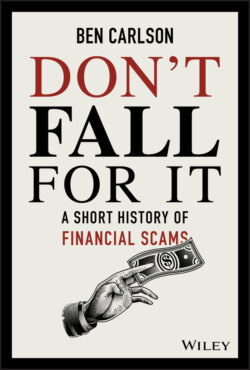Читать книгу Don't Fall For It - Carlson Ben, Ben Carlson - Страница 9
Radio
ОглавлениеRadio was an entirely new medium for the mainstream public in the 1920s. It not only allowed broadcasters to reach large groups of people all at once across the country, it also allowed them to capture people’s attention in their own homes. Radio was truly one of the first technological breakthroughs that allowed families to have leisure time with one another in their own living rooms where they didn’t have to pay attention to one another.
Companies began advertising their products in the late nineteenth century, but the 1920s is when advertising exploded into popular culture. The radio had a great deal to do with its spread. The first commercial radio station was launched in 1920. By the end of the decade, radio penetration went from basically zero to close to 40% of households. By 1940, more than 80% of households had a radio. The adoption of radios in households was faster than electricity, automobiles, or the telephone. Comedian George Burns wrote in his biography, “It’s impossible to explain the impact the radio had on the world to anyone who didn’t live through that time.”[14]
Radio sales doubled in 1923, and then tripled from there by 1924. The biggest reason radio spread like wildfire is because it was free. There was nothing else to pay for once you purchased it. And the reason it was free is because the business model was predicated on advertising. The swift rise in radio ownership coincided perfectly with Brinkley’s rise to prominence as a healer of all things to all people with ailments. Brinkley was a world-class charlatan, but according to one media historian he was also, “the man who, perhaps, more than any other, foresaw the great potentialities of radio as an advertising medium.”[15]
Advertising these days is everywhere you look. It’s on the websites, social media, billboards, TV, radio, and podcasts. But advertising wasn’t always so ingrained in our lives. When the radio went mainstream in the 1920s and revolutionized how we communicate with large groups of people, it was controversial to advertise on the platform. In 1922, future president Herbert Hoover even said, “It is inconceivable that we should allow so great a possibility for service, for news, for entertainment, for education, and for vital commercial purposes to be drowned out in advertising chatter.”[16]
Brinkley saw the future well before many businesses and invested heavily into radio to spread his message. By 1923, tiny Milford, Kansas had the fourth largest radio station in the country. How did Brinkley pull off this feat? He was essentially the Dr. Ruth of his day, talking about sex on the radio, something that was a taboo subject at the time. He also used radio as a sales tactic for his services and the new line of “medicine” he created. The radio show he produced was basically the WebMD of the early twentieth century. People would write in questions about their illness or injury, which Brinkley would read aloud on his show. Prescriptions were then given on air, which listeners could then go buy from the more than 500 drugstores he developed relationships with all over the country.[17]
No self-respecting doctor would hand out prescriptions without first examining the patient and making a diagnosis, but Brinkley wasn’t trying to appeal to reason: he was trying to appeal to people’s worst fears. Snake oil salesmen had always targeted people’s emotions, and Brinkley was no different. Now he had the ability to do so on a massive scale. This entailed not only promoting his goat gland operation, but an entire line-up of healthcare products and services.
The Kansas State Medical Board eventually revoked his medical license on the grounds of “gross immorality and unprofessional conduct.” The Kansas City Star proclaimed: “The superquack of Milford is finished.”[18]
Narrator: He was not finished.
